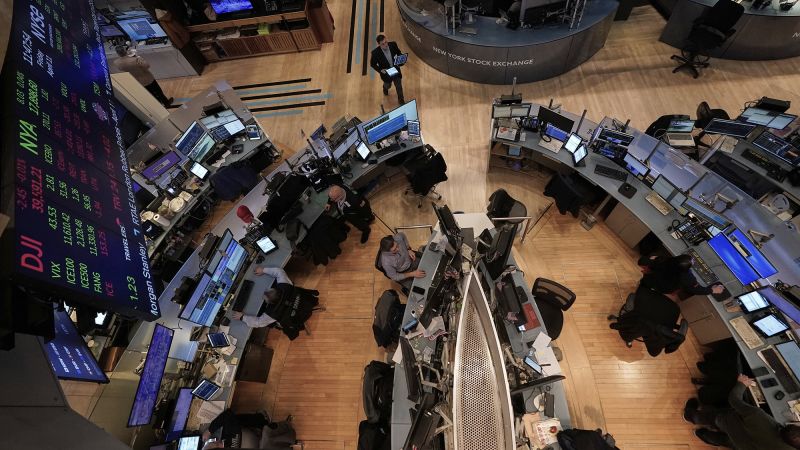The recent developments in the U.S. financial markets have drawn considerable attention as the stock market displayed a positive response following the Trump administration’s announcement regarding tariff exemptions for various electronic imports from China. On a Monday morning, U.S. stocks surged, driven primarily by these tariff exemptions, which aided in driving up the market sentiment among traders and investors.
The Dow Jones Industrial Average witnessed an increase of 250 points, translating to a 0.6% rise in morning trading. The Standard & Poor’s 500 Index (S&P 500) experienced a 0.65% gain, alongside a 0.5% increase in the tech-centric Nasdaq Composite. These gains indicated a boost in confidence and positivity in the market from traders who were encouraged by the adoption of these exemptions, which were formally announced through a notice from U.S. Customs and Border Protection late last week.
The exemptions arrive shortly after President Donald Trump wielded a tariff rate of 145% on Chinese imports, a move that has created unease in the marketplace. Importantly, while these exemptions relate specifically to electronics, they do not encompass the existing 20% tariff directed at imports from China connected to the ongoing issue surrounding the fentanyl trade. Tech bigwigs like Apple experienced significant gains following these announcements, reflecting the positive market sentiment.
The excitement in the markets, however, has been met with a sense of uncertainty regarding the broader implications of the ongoing trade war with China. Commerce Secretary Howard Lutnick indicated that these exemptions may only serve as a temporary respite. He subsequently warned that these electronic goods would face additional levies in the future. On an appearance with ABC News, Lutnick clarified that while electronics might currently be excluded from the reciprocal tariffs, they would soon fall under the new semiconductor tariffs expected to be implemented in the coming months.
Internationally, a broader rally in stock markets was observed, with Europe seeing a noteworthy increase in the benchmark STOXX 600, which rose by 2.77%. Similarly, Germany’s DAX index climbed by 2.88%. In Asia, Japan’s Nikkei 225 index also rose by 1.2%, while Hong Kong’s Hang Seng index saw a 2.4% increase. Taiwan’s benchmark index was the only exception, marginally declining by 0.8%.
The U.S. stock market has been through considerable turbulence in recent weeks. The introduction of reciprocal tariffs and the subsequent announcement of a 90-day pause led to significant fluctuations, with the S&P 500 falling by a shocking 9% in the first week of April, only to subsequently recover with a 5.7% rise the following week. This volatility peaked when the S&P 500 recorded its third-largest single-day gain in modern history, following Trump’s announcement regarding the tariff pause. Notably, despite these gains, the S&P 500 remained below its closing price from early April, preceding the tariff declarations.
The journey ahead indicates that Wall Street is aiming to maintain the momentum of the rally; however, uncertainties persist. The vague nature of Trump’s trade policy continues to leave traders without clear guidelines for positioning their investments, thus igniting apprehensions regarding the trajectory of the U.S. economy. Analysts from Morgan Stanley remarked that while any delay in tariffs might provide short-term benefits, it doesn’t equate to their complete removal, highlighting concerns that prolonged uncertainty could undermine business confidence and spending.
Goldman Sachs CEO David Solomon acknowledged a “markedly different operating environment” than earlier in the year, noting increasing concerns about a potential recession amidst signs of slowing economic activity. Investors, including institutional leaders and corporate CEOs, are expressing worries regarding the overall uncertainty, which is hampering their ability to execute pivotal decisions related to business operations.
In an alarming commentary, billionaire investor Ray Dalio warned that the current tariff situation has brought the U.S. economy to a precarious point, close to recession, and possible implications of even more dire economic conditions if the issue is not managed effectively. This sentiment aligns with the downgrades from several financial institutions, including Citi, which recently lowered their year-end target for the S&P 500 from 6,500 to 5,800.
As investors gear up for another trading week, they set their sights on the U.S. Treasury market, which has recently witnessed unusual volatility, prompting speculations regarding its status as a safe haven. On Monday, U.S. Treasuries saw slight gains, stabilizing after last week’s downturn, while yield on the 10-year Treasury note hovered around 4.4%.
In currency markets, the U.S. dollar index fell by 0.4%, marking its largest weekly drop since 2022. Meanwhile, gold emerged as a favored safe haven asset, soaring in price, reflecting heightened demand amid economic uncertainty. As investors opted for stability, gold prices eclipsed $3,200 per troy ounce, showcasing a notable increase of over 21%



